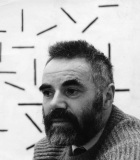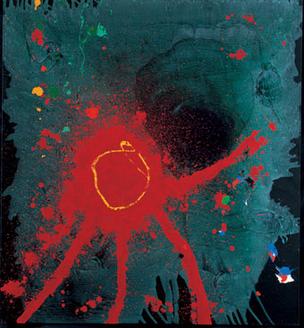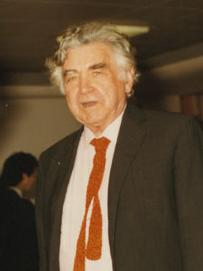Related Research Articles

Abstract art uses visual language of shape, form, color and line to create a composition which may exist with a degree of independence from visual references in the world.

Gillian Ayres was an English painter. She is best known for abstract painting and printmaking using vibrant colours, which earned her a Turner Prize nomination.

Hard-edge painting is painting in which abrupt transitions are found between color areas. Color areas often consist of one unvarying color. The Hard-edge painting style is related to Geometric abstraction, Op Art, Post-painterly Abstraction, and Color Field painting.

Ronald Brooks Kitaj was an American artist who spent much of his life in England.

Auguste Herbin was a French painter of modern art. He is best known for his Cubist and abstract paintings consisting of colorful geometric figures. He co-founded the groups Abstraction-Création and Salon des Réalités Nouvelles which promoted non-figurative abstract art.
Trevor Bell was an English Leeds-born artist and contemporary visual artist.

Edwin John Victor Pasmore, CH, CBE was a British artist. He pioneered the development of abstract art in Britain in the 1940s and 1950s.
Geoffrey Arthur Tibble was an English artist prominent in the Objective Abstraction movement.

Lyrical abstraction is either of two related but distinct trends in Post-war Modernist painting:
Callum Innes is a Scottish abstract painter, a former Turner Prize nominee and winner of the Jerwood Painting Prize. He lives and works in Edinburgh, Scotland.

Ronald "Ron" Davis is an American painter whose work is associated with geometric abstraction, abstract illusionism, lyrical abstraction, hard-edge painting, shaped canvas painting, color field painting, and 3D computer graphics. He is a veteran of nearly seventy solo exhibitions and hundreds of group exhibitions.
Concrete art was an art movement with a strong emphasis on geometrical abstraction. The term was first formulated by Theo van Doesburg and was then used by him in 1930 to define the difference between his vision of art and that of other abstract artists of the time. After his death in 1931, the term was further defined and popularized by Max Bill, who organized the first international exhibition in 1944 and went on to help promote the style in Latin America. The term was taken up widely after World War 2 and promoted through a number of international exhibitions and art movements.

Richard Allen was a British Minimalist, Abstract, Systems, Fundamental, and Geometric painter and printmaker. Allen worked prolifically from 1960 until his death, in 1999, from motor neurone disease.
J D H Catleugh was a British abstract artist whose career began in the 1950s and continued until his death in 2009.

John Hoyland RA was a London-based British artist. He was one of the country's leading abstract painters.

(Herbert George) Rodrigo Moynihan was an English painter, credited with being a pioneer of abstract painting in England.

Stephen Greene was an American artist known for his abstract paintings and in the 1940s his social realist figure paintings.

Jeffrey Steele (1931–2021) was an abstract painter and founder of the Systems Group.
Objective abstraction was a British art movement c. 1933–1936.
Amy Ellingson is an American contemporary abstract painter. She is a native of the San Francisco Bay Area and currently lives and works in Santa Fe, New Mexico.
References
- ↑ "Stephens, Chris (1997) Edgar Hubert 1906-85: Artist biography, Tate website" . Retrieved 6 September 2014.
- ↑ "About the Department of Art, University of Reading" . Retrieved 20 December 2014.
- ↑ "William Townsend papers, University College London archive" . Retrieved 10 September 2014.
- ↑ "Stephens, Chris (1997) Edgar Hubert 1906-85: Artist biography, Tate website" . Retrieved 6 September 2014.
- ↑ "Stephens, Chris (1997) Edgar Hubert, Painting 1935-6: Catalogue entry, Tate website" . Retrieved 6 September 2014.
- ↑ "Stephens, Chris (1997) Edgar Hubert, Painting 1935-6: Catalogue entry, Tate website" . Retrieved 6 September 2014.
- ↑ "Stephens, Chris (1997) Edgar Hubert 1906-85: Artist biography, Tate website" . Retrieved 6 September 2014.
- ↑ "Stephens, Chris (1997) Edgar Hubert 1906-85: Artist biography, Tate website" . Retrieved 6 September 2014.
- ↑ "Institute of Contemporary Arts Exhibitions List (pdf)" (PDF). Archived from the original (PDF) on 23 May 2014. Retrieved 5 September 2014.
- ↑ "Institute of Contemporary Arts Exhibitions List (pdf)" (PDF). Archived from the original (PDF) on 23 May 2014. Retrieved 5 September 2014.
- ↑ "Edgar Hubert, Drawing 1957, Victoria and Albert Museum (V&A), referenced as shown at ICA, 1958" . Retrieved 7 September 2014.
- ↑ "Edgar Hubert, British Council". Archived from the original on 5 September 2014. Retrieved 5 September 2014.
- ↑ "La Jeune Peinture en Grande Bretagne, British Council" . Retrieved 5 September 2014.
- ↑ "Edgar Hubert, Fine Art Society". Archived from the original on 5 September 2014. Retrieved 5 September 2014.
- ↑ "Edgar Hubert, Jerwood Collection, Art UK website" . Retrieved 29 September 2019.